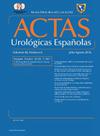内镜内尿道切除术后对大疱性尿道狭窄症的预测因素评估
IF 1.2
4区 医学
Q3 UROLOGY & NEPHROLOGY
引用次数: 0
摘要
直接视觉内尿道切开术(DVIU)通常是球尿道狭窄(US)患者的首选治疗方法。器械和手术技术的进步有助于减少相关并发症。尽管DVIU具有良好的成功率,但预测更好结果的各种因素已被研究,包括患者特征、狭窄特征和手术方面。我们研究的主要目的是评估成功的预测因素。方法:我们对我院30年来行内窥镜尿道切开术的患者进行回顾性描述性研究。在进行的788例DVIU中,我们选择了491例(62.3%)进行了球部US,随访时间至少为12个月。我们检查了获得的临床结果,并评估了不同患者特征、狭窄相关因素和与临床成功相关的手术方面之间的关系,这些因素被认为是避免进一步干预狭窄复发。计算描述性统计数据,并应用参数和非参数比较检验。Kaplan-Meier生存分析用于评估复发时间。结果平均狭窄长度为1.2 cm (SD 0.5),仅有12例患者在DVIU时出现球区超过1个US。中位随访170个月后,67.4%的患者没有出现临床复发。术后出现严重并发症的病例占0.4%,需要住院过夜的病例占4.5%。临床复发与既往盆腔放疗史(OR 2.8, 95%IC 1.3-22.2)、主动吸烟史(OR 2.1, 95%IC 1.6-2.4)、狭窄感染性病因学(OR 2.3, 95%IC 1.6-8)、既往尿道成形术史(OR 2.5, 95%IC 1.7-3.2)、术后尿管尺寸较大(OR 1.8, 95%IC 1.1-2.9)呈正相关。第一次DVIU术后复发的中位时间为65个月,第二次为60个月,第三次为32个月,第四次为6个月。结论DVIU可安全处理球囊脓肿。最好的临床成功是在未接受过照射、不吸烟、没有既往尿道成形术的患者中取得的。重复手术与较短的临床复发时间显著相关。本文章由计算机程序翻译,如有差异,请以英文原文为准。
Evaluación de los factores predictivos tras uretrotomía interna endoscópica para estenosis de uretra bulbar
Introduction
Direct vision internal urethrotomy (DVIU) is usually the first treatment offered to patients with bulbar urethral strictures (US). Advances in devices and surgical techniques have contributed to reducing associated complications. Despite the favorable success rate of DVIU, various factors predicting better outcomes have been studied, including patient characteristics, stricture features, and procedural aspects. The main aim of our study is to assess predictive factors for success.
Methods
We conducted a retrospective descriptive study of patients who underwent endoscopic internal urethrotomy at our hospital over a 30 year period. Out of 788 DVIU performed, we selected 491 (62.3%) conducted for bulbar US with a minimum follow-up of 12 months. We examined clinical outcomes obtained, and assessed the relationship between different patient characteristics, stricture-related factors and procedural aspects related with clinical success -considered as the avoidance of further interventions for stricture recurrence-. Descriptive statistics were calculated and parametrical and non-parametrical comparative tests were applied. Kaplan-Meier survival analysis was used for evaluating time until recurrence.
Results
Mean stricture length was 1.2 cm (SD 0.5), with only 12 patients presenting with more than 1 US in the bulbar area during DVIU. After a median follow-up of 170 months, 67.4% of patients did not experience clinical recurrence. Severe postoperative complications appear in 0.4% of cases, and need for overnight admission was 4.5%. A positive association was observed between clinical recurrence and a history of prior pelvic radiotherapy (OR 2.8, 95%IC 1.3-22.2), active smoking (OR 2.1, 95% IC 1.6-2.4), infectious etiology of stricture (OR 2.3, 95% IC 1.6-8), history of previous urethroplasty (OR 2.5, 95% IC 1.7-3.2), and higher postoperative urinary catheter sizes (OR 1.8 95% IC 1.1-2.9). Median time until recurrence after the first DVIU was 65 months, after the second was 60 months, after the third was 32 months, and after the fourth was 6 months.
Conclusions
Bulbar US could be safely managed with DVIU. The best clinical success is achieved in non-irradiated, non-smoker patients, without prior urethroplasties. The repetition of the procedure is significantly associated with a shorter time to clinical recurrence.
求助全文
通过发布文献求助,成功后即可免费获取论文全文。
去求助
来源期刊

Actas urologicas espanolas
UROLOGY & NEPHROLOGY-
CiteScore
1.90
自引率
0.00%
发文量
98
审稿时长
46 days
期刊介绍:
Actas Urológicas Españolas is an international journal dedicated to urological diseases and renal transplant. It has been the official publication of the Spanish Urology Association since 1974 and of the American Urology Confederation since 2008. Its articles cover all aspects related to urology.
Actas Urológicas Españolas, governed by the peer review system (double blinded), is published online in Spanish and English. Consequently, manuscripts may be sent in Spanish or English and bidirectional free cost translation will be provided.
 求助内容:
求助内容: 应助结果提醒方式:
应助结果提醒方式:


